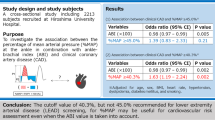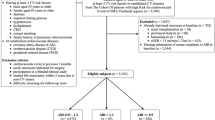Abstract
Ankle brachial pressure index (ABPI) is a non-invasive marker of atherosclerosis, helpful to identify subjects at high-risk for coronary heart disease (CHD) among large populations with cardiovascular disease (CVD) risk factors. The diagnostic role of ABPI has been also recognized in patients with diabetes. In the present study, the role of an ABPI score <0.90 in predicting CHD has been evaluated in a large series of patients with Type 2 diabetes mellitus and compared to other known CVD risk factors. Nine hundred and sixty-nine (mean age was 66.1 yr) consecutive patients with Type 2 diabetes mellitus were evaluated. The patients were followed-up for 18.3±5.2 months (range 12–24) and all events of CHD, defined as myocardial infarction, unstable and resting angina or coronary atherosclerosis at the instrumental investigation (at the coronary angiography and/or perfusion stress testing) were recorded. A rate of 17.5% of CHD events were recorded in diabetic population during the follow-up period. The relative risk of CHD was significantly increased for male patients [odds ratio (OR): 1.6; 95% confidence interval (CI): 1.1–2.2], patients with age ≥66 yr (OR: 1.8; 95% CI: 1.3–2.5), body mass index (BMI) >30 (OR: 1.5; 95% CI: 1.1–2.1), waist circumference >88 cm for females and 102 cm for males (OR: 1.5; 95% CI: 1.0–2.1), proteinuria ≥30 μg per min (OR: 1.6; 95% CI: 1.1–2.3), LDL-cholesterol ≥100 mg/dl (OR: 2.1; 95% CI: 1.5–3.0), glycated hemoglobin >7% (OR: 1.6; 95% CI: 1.1–2.3), insulin therapy (OR: 1.9; 95% CI: 1.3–2.9), and ABPI <0.90 (OR: 3.7; 95% CI: 2.2–6.2). BMI was higher in patients with ABPI <0.90 than in those with ABPI ≥0.90 (p<0.05). At the multivariate analysis, ABPI <0.90 was the best factor independently associated with CHD (p<0.001). APBI <0.90 is strongly associated to CHD in Type 2 diabetic patients. We recommend to use ABPI in diabetic patients and to carefully monitor diabetic subjects with an ABPI lower than 0.90.
Similar content being viewed by others
References
Dorman JS, Laporte RE, Kuller LH, et al. The Pitts-burgh insulin-dependent diabetes mellitus (IDDM) morbidity and mortality study. Mortality results. Diabetes 1984, 33: 271–6.
Krolewski AS, Warram JH, Rand LI, Kahan CR. Epidemiologic approach to the etiology of type I diabetes mellitus and its complications. N Engl J Med 1987, 317: 1390–8.
Lloyd CE, Kuller LH, Ellis D, Becker DJ, Wing RR, Orchard TJ. Coronary arterydisease in IDDM. Gender differences in risk factors but not risk. Arterioscler Thromb Vasc Biol 1996, 16: 720–6.
Tuomilehto J, Borch-Johnsen K, Molarius A, et al. Incidence of cardiovascular disease in Type 1 (insulin-dependent) diabetic subjects with and with-out diabetic nephropathy in Finland. Diabetologia 1998, 41: 784–90.
Grundy SM, Benjamin IJ, Burke GL, et al. Diabetes and cardiovascular disease: a statement for healthcare professionals from the American Heart Association. Circulation 1999, 100: 1134–46.
Haffner SM, Lehto S, Ronnemaa T, Pyroala K, Laakso M. Mortality from coronary heart disease in subjects with type 2 diabetes and in non-diabetic subjects with and without prior myocardial infarction. N Engl J Med 1998, 339: 229–34.
Resnick HE, Lindsay RS, McDermott MM, et al. Relationship of high and low ankle brachial index to all-cause and cardiovascular disease mortality: the Strong Heart Study. Circulation 2004,109: 733–9.
Fabsitz RR, Sidawy AN, Go O, et al. Prevalence of peripheral arterial disease and associated risk factors in American Indians: the Strong Heart Study. Am J Epidemiol 1999,149: 330–8.
McKenna M, Wolfson S, Kuller L. The ratio of ankle and arm arterial pressure as an independent predictor of mortality. Atherosclerosis 1991, 87: 119–28.
McDermott MM, Feinglass J, Slavensky R, Pearce WH. The ankle-brachial index as a predictor of survival in patients with peripheral vascular disease. J Gen Intern Med 1994, 9: 445–9.
Newman AB, Sutton-Tyrrell K, Vogt MT, Kuller LH. Morbidity and mortality in hypertensive adults with a low ankle/arm blood pressure index. JAMA 1993, 270: 487–9.
Zheng ZJ, Sharrett AR, Chambless LE, et al. Association of ankle-brachial index with clinical coronary heart disease, stroke and preclinical carotid and popliteal atherosclerosis: the Atherosclerosis Risk in Communities (ARIC) Study. Atherosclerosis 1997, 131: 115–25.
Fine JJ, Hopkins CB, Hall PA. Abnormal ankle brachial indices may predict cardiovascular disease among diabetic patients without known heart disease. Circ J 2005, 69: 798–801.
Obesity. A report of the Royal College of Physicians. J R Coll Physicians Lond 1983,17: 5–65.
Yanovski SZ. A practical approach to treatment of the obese patient. Arch Fam Med 1993, 2: 309–16.
Expert Panel on Detection, Evaluation, and Treatment of High Blood Cholesterol in Adults. Executive Summary of The Third Report of The National Cholesterol Education Program (NCEP) Expert Panel on Detection, Evaluation, and Treatment of High Blood Cholesterol in Adults (Adult Treatment Panel III). JAMA2001, 285: 2486–97.
Daigle RJ. Techniques in non-invasive vascular diagnostics: Protocol and procedures guideline manual. Rolling Hills Estates, CA: Academy Medical Systems 1999, 134.
Feldman EL, Stevens MJ, Thomas PK, Brown MB, Canal N, Greene DA. A practical two-step quantitative clinical and electrophysiological assessment for the diagnosis and staging of diabetic neuropathy. Diabetes Care 1994, 17: 1281–9.
Lunetta M, Le Moli R, Grasso G, Sangiorgio L. A simplified diagnostic test for ambulatory screening of peripheral diabetic neuropathy. Diabetes Res Clin Pract 1998, 39: 165–72.
Moghtaderi A, Bakhshipour A, Rashidi H. Validation of Michigan neuropathy screening instrument for diabetic peripheral neuropathy. Clin Neurol Neurosurg 2006, 108: 477–81.
Selvin E, Marinopoulos S, Berkenblit G, et al. Meta-analysis: glycosylated hemoglobin and cardiovascular disease in diabetes mellitus. Ann Intern Med 2004,141: 421–31.
Kobayashi K, Akishita M, Yu W, Hashimoto M, Ohni M, Toba K. Interrelationship between non-invasive measurements of atherosclerosis: flow-mediated dilation of brachial artery, carotid intima-media thickness and pulse wave velocity. Atherosclerosis 2004, 173: 13–8.
Smith SC Jr, Greenland P, Grundy SM. AHA Conference Proceedings. Prevention conference V: beyond secondary prevention: identifying the high-risk patient for primary prevention: executive summary. American Heart Association. Circulation 2000, 101: 111–6.
Grundy SM, Howard B, Smith S Jr, Eckel R, Redberg R, Bonow RO. Prevention Conference VI: Diabetes and Cardiovascular Disease: executive summary: conference proceeding for healthcare professionals from a special writing group of the American Heart Association. Circulation 2002,105: 2231–9.
Wierzbicki AS, Reynolds TM, Gill K Alg S, Crook MA. A comparison of algorithms for initiation of lipid lowering therapy in primary prevention of coronary heart disease. J Cardiovasc Risk 2000, 7: 63–71.
Wilson PW, D’Agostino RB, Levy D, Belanger AM, Silbershatz H, Kannel WB. Prediction of coronary heart disease using risk factor categories. Circulation 1998, 97: 1837–47.
Wood D, De Backer G, Faergeman O, Graham I, Mancia G, Pyorala K. Prevention of coronary heart disease in clinical practice: recommendations of the Second Joint Task Force of European and other Societies on Coronary Prevention. Atherosclerosis 1998, 7: 199–270.
Greenland P, Grundy S, Pasternak RC, Lenfant C. Problems on the pathway from risk assessment to risk reduction. Circulation 1998, 97: 1761–2.
Grundy SM, Pasternak R, Grenland P, Smith S Jr, Fuster V. AHA/ACC scientific statement: assessment of cardiovascular risk by use of multiple-risk-factor assessment equations: a statement for healthcare professionals from the American Heart Association and American College of Cardiology. J Am Coll Cardiol 1999, 34: 1348–59.
Stoffers HE, Kester AD, Kaiser V, Rinkens PE, Kistlaar PJ, Knottnerus JA. The diagnostic value of the measurement of the ankle-brachial systolic pressure index in primary health care. J Clin Epidemiol 1996, 49: 1401–5.
Zander E, Heinke P, Reindel J, et al. Peripherial arterial disease in diabetes mellitus type 1 and type 2: are there different risk factors? Vasa 2002, 3: 249–54.
Newman AB, Shemanski L, Manolio TA, et al. Ankle-arm index as a predictor of cardiovascular disease and mortality in the Cardiovascular Health study. The Cardiovascular Health Study Group. Arterioscler Thromb Vasc Biol 1999, 19: 538–45.
Abbott RD, Rodriguez BL, Petrovitch H, et al. Ankle-brachial blood pressure in elderly men and the risk of stroke: the Honolulu Heart Program. J Clin Epidemiol 2001, 54: 973–8.
Murabito JM, Evans JC, Nieto K, Larson MG, Levy D, Wilson PF. Prevalence and clinical correlates of peripheral arteria disease in the Framingham Offspring Study. Am Heart J 2002,143: 961–5.
Wild SH, Byrne CD, Smith FB, Lee AJ, Fowkes FG. Low ankle-brachial pressure index predicts increased risk of cardiovascular disease independent of the metabolic syndrome and conventional cardiovascular risk factors in the Edinburgh Artery Study. Diabetes Care 2006, 29: 637–42.
Papamichael CM, Lekakis JP, Stamatelopoulos KS, et al. Ankle-brachial index as a predictor of the extent of coronary atherosclerosis and cardiovascular events in patients with coronary artery disease. Am J Cardiol 2000, 86: 615–8.
Dieter RS, Tomasson J, Gudjonsson T, et al. Lower extremity peripheral arterial disease in hospitalized patients with coronary artery disease. Vasc Med 2003, 8: 233–6.
Wattanakit K, Folsom AR, Selvin E, et al. Risk factors for peripheral arterial disease incidence in persons with diabetes: the Atherosclerosis Risk in Communities (ARIC) Study. Atherosclerosis 2005, 180: 389–97.
Faglia E, Caravaggi C, Marchetti R, et al.; SCAR (Screening for Arteriopathy) Study Group. Screening for peripheral arterial disease by means of the ankle-brachial index in newly diagnosed Type 2 diabetic patients. Diabet Med 2005, 22: 1310–4.
Lange S, Diehm C, Darius H, et al. High prevalence of peripheral arterial disease and low treatment rates in elderly primary care patients with diabetes. Exp Clin Endocrinol Diabetes 2004,112: 566–73.
Norman PE, Davis WA, Bruce DG, Davis TM. Peripheral arterial disease and risk of cardiac death in type 2 diabetes: the Fremantle Diabetes Study. Diabetes Care 2006, 29: 575–80.
Author information
Authors and Affiliations
Corresponding author
Rights and permissions
About this article
Cite this article
Filippella, M., Lillaz, E., Ciccarelli, A. et al. Ankle brachial pressure index usefulness as predictor factor for coronary heart disease in diabetic patients. J Endocrinol Invest 30, 721–725 (2007). https://doi.org/10.1007/BF03350808
Accepted:
Published:
Issue Date:
DOI: https://doi.org/10.1007/BF03350808




